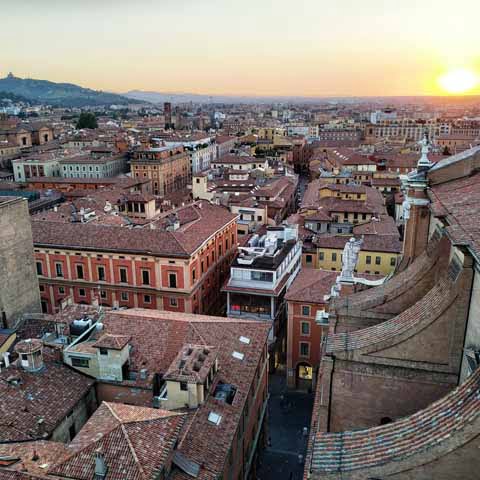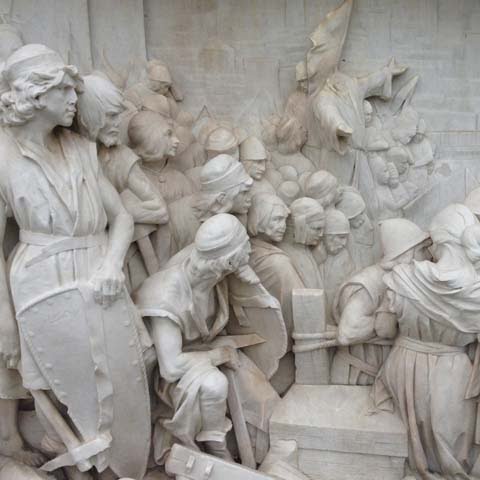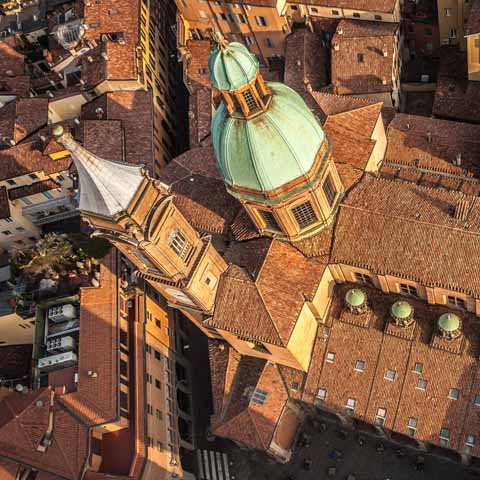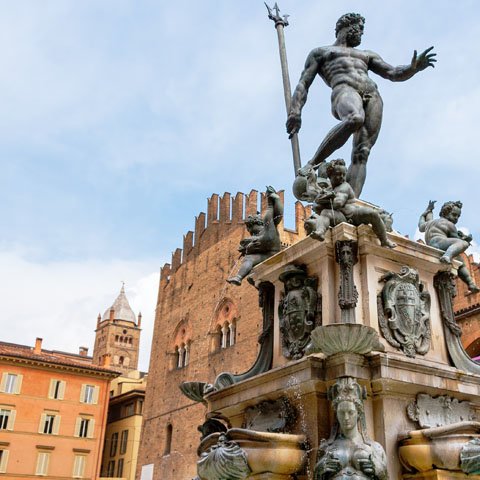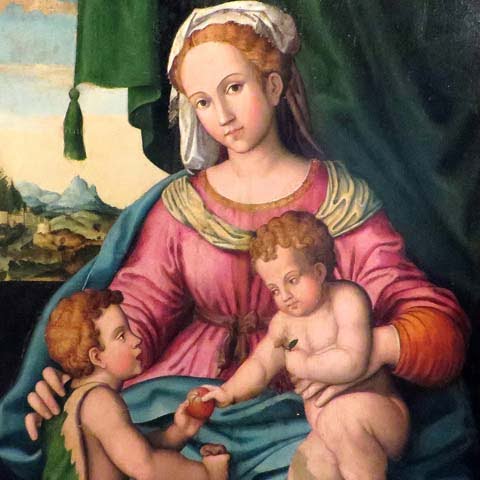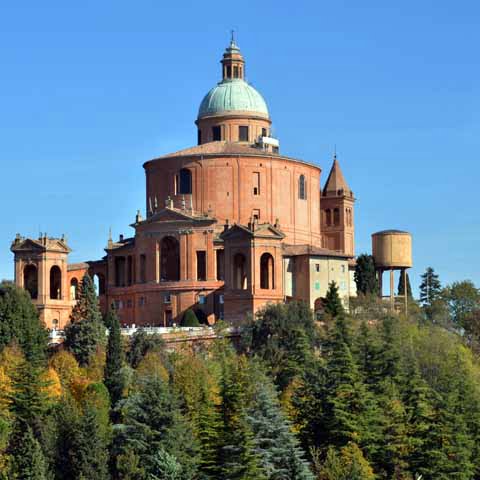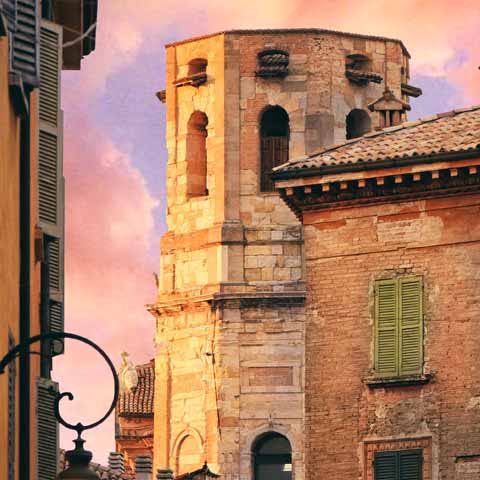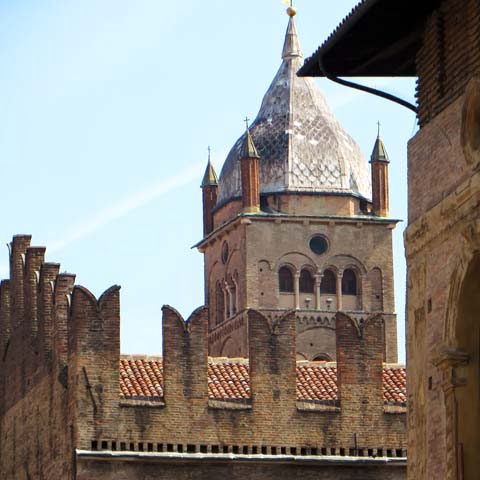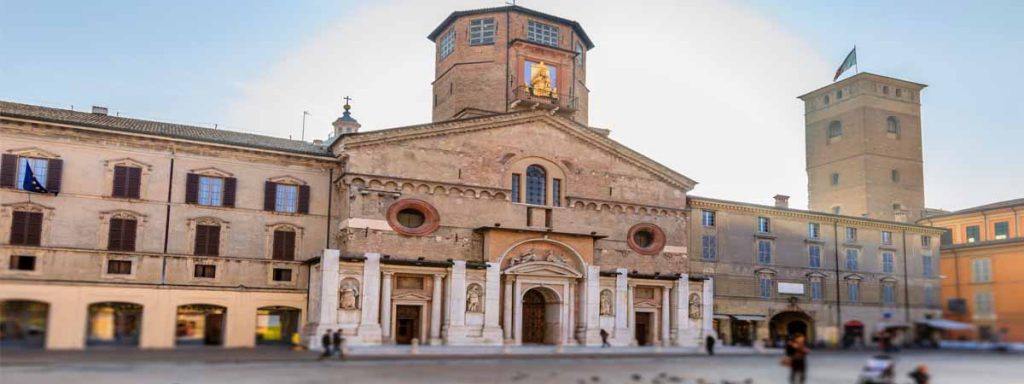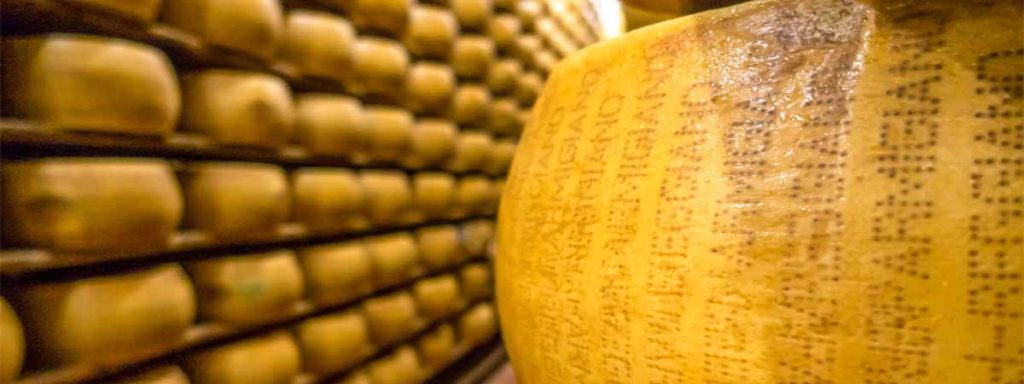In the heart of Northern Italy lies the cultural mecca of Bologna. Part of the Emilia-Romagna region, this ancient city is rich with tradition while also fostering a modern and thriving culture that makes Bologna appealing to a wide array of travelers.
To say that Bologna is ancient is not a careless use of words. The city has roots dating back to the year 1000 BC. The city’s historical center has withstood the test of time and today it is considered to be one of the most extensive in Italy. Here you will find captivating Medieval, Renaissance, and Baroque structures such as great towers, ancient churches, and a variety of museums. Therefore, it is no surprise that Bologna was declared the European Capital of Culture in the year 2000.
ARCHITECTURE
Particularly when viewing the uniformly red-roofed structures of Bologna from the air, the city’s Roman heritage is quite visible via a grid pattern typical of those types of settlements. The city is a compact maze of squares, streets, and buildings.
Largely due to its Medieval influences, the city was at one time home to more than one hundred eighty defense towers. Approximately twenty of those still rise tall above the city today. Two of these towers, Asinelli and Garisenda, stand next to each other and lean slightly. Asinelli Tower is more than three hundred eighteen feet tall and Garisenda Tower is more than one hundred fifty-seven feet tall. The set of towers are referred to as Due Torri and together have become a symbol of the city. With advance reservations and a pair of good walking shoes, visitors can climb the four hundred ninety-eight steps for an unparalleled view of the city from the sky.
Another noteworthy defensive tower that still remains is Torre Prendiparte. The twelfth century structure is one hundred ninety-three feet tall (the second tallest in the city after the Asinelli Tower) and is located in Piazza Prendiparte, somewhat close to Due Torri. Today the tower is home to a unique bed and breakfast and event venue, but it is still possible to climb the twelve flights of stairs and enjoy spectacular views of Bologna from the rooftop terrace.
Piazza Maggiore is considered by many to be the heartbeat of Bologna. This square is home to the Basilica of San Petronio and several gorgeous buildings such as Pallazo d’Accursio and Palazzo del Podestà. It is a popular meeting place for locals who refer to it simply as the piazza. The open-air square is home to a number of community events including musical concerts, outdoor movie showings, and occasional markets.
Located in the piazza is one of the structures Bologna is best known for, the Basilica of San Petronio. Construction began in the late fourteenth century and the church has been expanded and renovated in the following centuries. Due to the timing of its construction, the Basilica is considered to be the last major work of the late Gothic period in Italy. The church was set to be the largest in the world until local funds were not enough to complete it. Nevertheless, the Basilica is still considered to be one of the largest churches, by volume, in the world and a remarkable architectural feat. The most striking characteristic of the church is the appearance of its partially finished façade in the front. The gothic exterior consists of exquisite pink hued marble on the bottom half and plain brown brickwork on the top half. The interior of the church features gorgeous archways, stained glass windows, and a network of twenty-two chapels. One last distinction for the Basilica di San Petronio is its marking of a meridian line calculated and designed by astronomer Giovanni Domenico Cassini who taught at the University of Bologna. The meridian line was used to determine the length of the tropical year and the schedules of the equinoxes and solstices, with a precision that was unbeatable at the time.
Though the Basilica of San Petronio is impressive in its grandeur, it is not Bologna’s Cathedral. Rather, that distinction falls to the Metropolitan Cathedral of San Pietro. This cathedral was christened as the “Metropolitan” by Pope Gregory XIII in the sixteenth century. Inside the church, visitors can take in the seventeenth century restorations as well as stunning paintings by renowned artists like Ludovico Carracci, Donato Creti, and Prospero Fontana. The cathedral’s bell tower reaches almost two hundred thirty feet tall and the bell is often rung in a unique cadence referred to as the Bolognese method.
The Santuario di Madonna di San Luca is one of the oldest churches in Bologna. With origins in the twelfth century, the current structure was built in the eighteenth century and sits atop a hill named Monte della Guardia overlooking the city. The sanctuary offers superb views from its hilltop perch that make it well worth the journey. In order to reach the church from Bologna, travelers can walk along a covered arcade that stretches for 2 miles, considered to be the longest in the world. The main basilica features a green dome at the top and the structure is built out on both sides of the basilica creating the form of a semicircle. The building itself is quite spectacular on the exterior, but it does not hold a candle to the interior. The inside of the building is simply exquisite with luxurious touches, ornate décor, and breathtaking religious frescoes. The church boasts works by Guido Reni, Guercino, and Giuseppe Cassioli, among others.
Once a central building and integral part of the University of Bologna, Archiginnasio is an architectural feat that is not to be missed. The sixteenth century building in Piazza Galvani is home to both the Municipal Library and the Anatomical Theater. The theater is made of impressive wood paneling with intricate details such as a number of statues of famous medical practitioners, elaborate chandeliers, and a stunning decorative wood paneled grid ceiling. In the center of the room is an anatomical table where students were educated about anatomy and witnessed demonstrations and dissections. Unfortunately, the original anatomical theater was almost completely destroyed during Allied bombings in 1944. However, following World War II, the site was painstakingly rebuilt using the pieces of the theater retrieved from the rubble.
ART
Bologna’s history of and commitment to art is evident by the wondrous artistic masterpieces found throughout the city as well as the city’s art school, Accademia di Belle Arti di Bologna. One of the foremost Italian painters of the nineteenth century, Giorgio Morandi, who was well-known for his still life paintings and prints, taught engraving at the campus. The school has three areas of membership: honorary, teaching, and correspondent. Students attending school there today are continuing the city’s historical commitment to the arts.
Spanning many centuries and resulting in an astonishing wealth of art and architecture, the Bolognese art movement hit its apex primarily in the fourteenth and seventeenth centuries, though the legacy of the Bolognese School still inspires artists in modern times. In the fourteenth century, artists in Bologna developed a style of painting that contrasted the dominating style followed by Giotto and the Florentine School. In the seventeenth century as well, local artists, such as Carracci, Guido Reni, and Guercino, developed an anti-Baroque style, which rivaled the contemporary style of Rome. Furthermore, the layout of the city is an art form in and of itself with its colonnades and roads that lend themselves to the discovery of Bologna’s magnificent artistic buildings.
One of the most renowned symbols of art in Bologna is the Fountain of Neptune. The fountain is located in Piazza del Nettuno, which is adjacent to Piazza Maggiore. This beautiful fountain reaches thirteen feet high, making it a focal point of the square and one of the reasons locals refer to it as Il Gigante, or Al Zigante in the Bolognese dialect. The work of art was originally commissioned by the church, to symbolize Pope Pius IV’s power. Interestingly, Neptune’s trident served as inspiration for the logo of luxury vehicle manufacturer Maserati, which was founded in Bologna.
Located near the center of the city, the Pinacoteca Nazionale di Bologna (Bologna National Gallery) displays paintings from the thirteenth century up to the eighteenth century. Considered to be one of Italy’s most important art galleries, the museum’s collection features masterpieces by Raphael, Titian, Guido Reni, and many more. In addition to its artistic heritage, the Bologna National Gallery is renowned for its temporary exhibitions and educational events. Furthermore, the Accademia di Belle Arti di Bologna is located in the same structure as the National Gallery. Among its many remarkable works, two of the more renowned pieces of art found in the gallery include the Ecstasy of St. Cecilia by Raphael and Christ & the Good Thief by Titian.
Bologna is a city rich in museums focusing on art, history, science, religion, and archeology. Another art museum that is characteristic of the city is the Museo d’Arte Moderna di Bologna (Bologna Modern Art Museum), also referred to using the acronym MAMbo. The expansive museum offers a permanent collection focusing on modern and experimental art in addition to hosting fascinating temporary exhibitions.
Also not to be missed are the sculptures and frescoes inside the Oratory dei Battuti. Located inside the Sanctuary of Santa Maria della Vita, the early seventeenth century structure designed by Floriano Ambrosini features sculptures such as Saint Proculus and Saint Petronius. When visiting the Oratory, do not forget to look up to see the depiction of the ascension of the Madonna.
SCIENCE
Thanks to the presence of the University of Bologna, many influential scientists have been tied to this magical city over the centuries. Among the most notable scientists is Marcello Malpighi, a biologist and physician during the seventeenth century. Due to his extensive research and experiments, he is referred to as the “Founder of microscopical anatomy, histology & Father of physiology and embryology.” Malpighi was one of the earliest scientists to study cells of the human body using a microscope. As a result, functions of the excretory system of the human body as well as parts of insects and plants have been named after him.
Among Bologna’s scientists from the eighteenth century, Laura Bassi deserves a mention. After studying at the University of Bologna, Bassi was the first woman in the world to earn a doctorate in science and the second woman overall to earn a PhD. With a strong interest in Newtonian mechanics, Bassi helped spread this theory throughout Italy. When she joined the faculty of the University of Bologna in 1732, she became the first female university professor in the world.
Influential Italian inventor Guglielmo Marconi was born in Bologna in 1847. Not only did he graduate from the University of Bologna, but Marconi also worked as a professor at his alma mater. Marconi’s numerous scientific achievements include the development of Marconi’s Law and the invention of the radio. In 1909, Marconi won the Nobel Prize for Physics with Karl Ferdinand Braun. In recognition of his scientific achievements, Bologna’s airport is named after Marconi and the Department of Electrical, Electronic, and Information Engineering at the University of Bologna is named in his honor.
LITERATURE
With a nickname like “La dotta” which means “the learned one”, it is no surprise that literature is a key component to education and culture in Bologna. Over the centuries, several important figures of Italian literature and poetry called Bologna home. Among the earliest was Guido Guinizelli, a thirteenth century poet that invented the Dolce stil novo (Sweet New Style), a literary style implemented by Dante Alighieri, author of the Divine Comedy.
Though he was born in Tuscany, influential Italian poet Giosuè Carducci spent many years in Bologna and taught Italian literature at the University of Bologna. Carducci is best remembered for being the first Italian to win the Nobel Prize for Literature in 1906. Another important poet with ties to Bologna is Giovanni Pascoli, who is considered to be among the greatest Italian poets of the Decadent Movement.
Alfredo Testoni was one of several influential nineteenth and twentieth century Italian playwrights and poets. Born in Bologna, he is best known for writing the comedy Il cardinale Lambertini (The Cardinal Lambertini). Testoni is also renowned for writing both in Italian and in the Bolognese dialect.
Several natives of Bologna, including Loriano Macchiavelli and Grazia Versani, are considered to be among the best thriller writers in Italy. Additionally, many foreign authors have drawn inspiration from this beautiful city and have chosen to set their books in Bologna, with the most notable example being John Grisham, whose suspense novel The Broker partially takes place in Bologna.
At the end of September, the city hosts a one-of-a-kind book festival in the Palazzo Re Enzo called Artelibro. The event is enjoyed by locals and visitors alike and is known for its book presentations and author meet and greets, as well as debates and exhibits.
MUSIC
Music is such a large part of the culture of Bologna, the city was designated as a 2006 United Nations Educational, Scientific and Cultural Organization (UNESCO) City of Music. The designation was given for the city’s musical tradition that continues to evolve and thrive in contemporary life and creation. With a distinction such as this, it seems fitting for the city to also be home to the music college Conservatorio Giovanni Battista Martini.
Music is part of the historical fabric of Bologna that is still evident today. Whether in the names of local streets, the presence of Teatro Comunale, or the shops that feature handcrafted violins, music is alive and well in Bologna.
Vicenzo Maria Carrati founded the Accademia Filarmonica of Bologna in the mid seventeenth century as a way of bringing together professional musicians. In the late eighteenth century, Mozart himself took an entrance exam to the Accademia Filarmonica. The clean copy of Mozart’s exam antiphon is still preserved in the academy.
Following World War II, jazz music became an immense source of enjoyment for city residents with Bologna attracting jazz musicians from all over the world. In the 1970s and 1980s, Bologna contributed greatly to Italy’s vast singer songwriter tradition through the work of local musicians such as Lucio Dalla, Francesco Guccini, and Gianni Morandi whose songs continue to inspire new generations of Italian musicians.
Although one can now witness whimsical displays of music in the city squares of Bologna and in music festivals throughout the year, two festivals stand out in particular. One is the AngelicA Festival Internazionale di Musica, a contemporary music festival featuring musicians from all over the world. This event is held during the months of May and June and has occurred annually since 1991. The second festival, the Bologna Jazz Festival, is held in November each year. Founded in 1958, this is the oldest jazz festival in Italy. Each year some of the best jazz musicians from Italy and all over the world participate in the festival.
CINEMA
Bologna is a city with a deep passion for cinema, as evidenced by its prestigious film library, Cineteca, as well as the numerous directors that have called the city home. Among the most important is Pier Paolo Pasolini a poet and writer who is considered to be one of Italy’s most influential film directors. An alumni of the University of Bologna, Pasolini’s appreciation for his hometown ran deep with several of his masterpieces filmed in Bologna including Edipo re. Italian director Pupi Avati was also born in Bologna and graduated from the University of Bologna as well. Best known for his thriller films, a majority of his works were filmed at least in part in Bologna.
Though Bologna is not widely represented in international films, the picturesque city has served as a filming location and setting for countless Italian films. In addition to Pasolini and Avati, several other influential Italian directors have chosen Bologna for their films including Giuseppe Tornatore, Alberto Sordi, and Gabriele Salvatores.
Cinema is so beloved in Bologna that each summer the Sotto Le Stelle Del Cinema Festival is held in Piazza Maggiore. During the festival, classic films are watched outdoors in the square on an enormous screen. Films typically include those restored by the Cineteca as well as newer films. Other film related festivals held in the city include the Future Film Festival, Il cinema ritrovato, Biografilm Festival, and Immaginaria.
To walk the porticoes and streets of Bologna is to bask in and soak up the culture of the city. The more time you are able to devote to the subtleties that make Bologna one of the most fascinating cities in Italy, the more you will be able to appreciate all the city and its people have to offer.
Don't just see Italy, live it.
Your dream trip to Italy has never been closer
No more endlessly scrolling travel sites. Our travel experts will craft the perfect, one-of-a-kind trip just for you.

300+
DESTINATIONS
We offer more Italian destinations than any travel site. Do and see more with Trips 2 Italy.
1 (of a kind)
ITINERARIES
Because your dream trip to Italy should be designed for you, not for the masses.
100%
PEACE OF MIND
From flights and accommodations, to food and activities - we take care of every detail.
